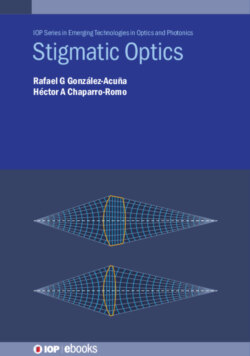Читать книгу Stigmatic Optics - Rafael G González-Acuña - Страница 15
На сайте Литреса книга снята с продажи.
1.4 The Gauss law
ОглавлениеWe start with Gauss’s law. Although, there are many ways to express this law and notation differs, the integral form of the Gauss law is customarily given the following expression,
∮SE⃗·n⃗da=qinε0,(1.6)
where n⃗ is the normal unit vector of the closed surface S, qin is the charge inside the closed surface S and ε0 is a constant called the permittivity free space. In the international system of units, where force is in newtons (N), distance in meters (m), and charge in coulombs (C),
ε0=8.85×10−12C2N−1m−2.(1.7)
First, let’s pay attention of the left side of equation (1.6). The left side of this equation is the mathematical representation of the electric flux—the number of electric field lines—crossing into a closed surface S. In the right side the total amount of charge contained within that surface is divided by a constant called the permittivity of free space. Therefore, what Gauss’s law tells us is an electric charge produces an electric field, and the flux of that field passing through any closed surface is proportional to the total charge inside the closed surface.
Let us assume that you have a closed surface S, where the shape and size of S are arbitrary. If there is no charge inside S, then, the electric flux is zero. If there is a positive charge inside S, then, the electric flux through the surface is positive. But, if you add an equal amount of negative charge, thus the total amount of charge inside S is zero, then, the electric flux again is zero.
There is another way to express Gauss’s law using the divergence theorem. The form is the following expression,
∇·E⃗=ρε0,(1.8)
where ρ is the density of charge inside and ∇ is the nabla operator,
∇=∂∂xi⃗+∂∂yj⃗+∂∂zk⃗(1.9)
∇·E⃗ is the divergence of the field E⃗. The divergence of the vector field is a scalar computation that indicates the tendency of the field to flow away from a point. Hence, Gauss’s law tells us that the divergence of the field E⃗ is the density of charge divided by the permittivity free space.
Here we limit ourselves to present this form of the Gauss law because the derivation of the divergence theorem is beyond the scope of the book. For a more detailed analysis of the divergence theorem, the reader is invited to read the references presented in the bibliography of this chapter.
